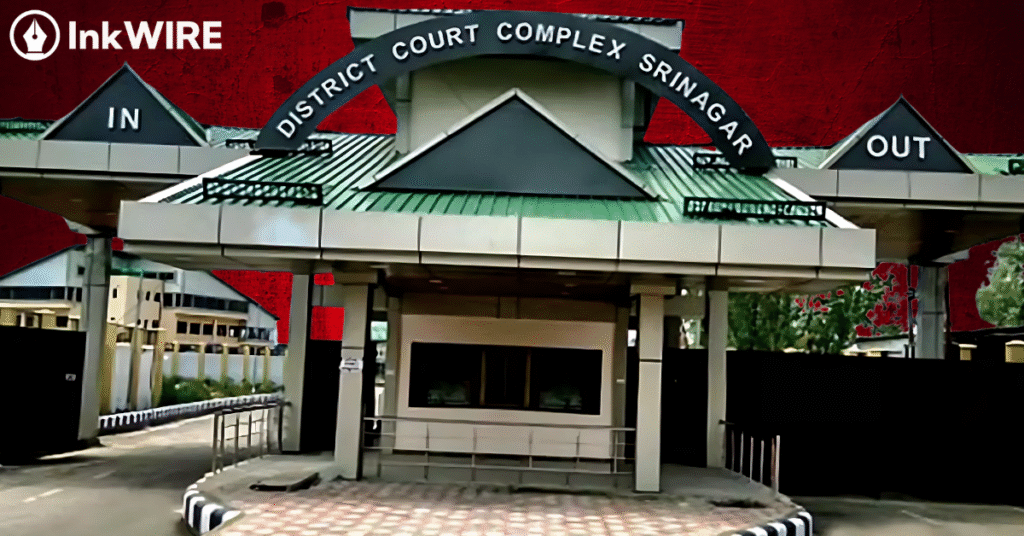Srinagar court compensation 1985 blast case brings justice after decades. A local judge awarded Rs 3.24 lakh to the victim’s family. This ruling holds the state accountable for security lapses. The bomb explosion claimed a young life. Authorities failed to protect the public.

Background of the Tragic Incident
October 13, 1985, marked a dark day. A bomb exploded at Radha Theatre. This happened in Srinagar’s Exhibition Grounds. Avis Ahmed Shah, aged 22, suffered severe injuries. He died the next day at SKIMS Soura.
Shah attended as an innocent visitor. No subversive links tied him. Family members filed a suit later. They blamed state negligence. Security measures fell short badly.
Moreover, plaintiffs argued strongly. Authorities should ensure safety. Public gatherings need protection. Lapses caused the death. Compensation became their demand.
Transitioning to details, the state denied liability. They admitted the blast occurred. Victim’s death stayed undisputed. Yet, responsibility evaded them. Courts would decide.
However, evidence mounted up. Witnesses confirmed facts. Documents supported claims. Trial proceeded slowly. Decades passed by.
Additionally, family persisted bravely. Legal representatives stepped in. Suit gained traction finally. Justice knocked at door.
Therefore, this Srinagar court compensation 1985 blast ruling matters. It revives old wounds. Healing starts now.
Court’s Key Findings on Liability
Judge Swati Gupta presided. She decreed the suit favorably. State bears vicarious liability. Security failure proved evident. Public safety lapsed here.
Furthermore, Article 21 came into play. It guarantees life protection. State must safeguard citizens. Any breach invites accountability. Restitution follows naturally.
The court observed keenly. “Deprivation of life cannot dismiss as tragedy,” it stated. Administrative setup answers for lapses. Duty of care binds them.
Moreover, deceased showed no involvement. Blast injuries killed him directly. State machinery faltered badly. Protection at public spots lacked.
Transition words like additionally guide us. Judge cited Supreme Court precedent. Lata Wadhwa case emphasized relief. State extends help to victims.
However, governments notify schemes. Terrorism victims get support. Bomb blast affected qualify too. This applies here.
Therefore, findings solidify claims. Srinagar court compensation 1985 blast sets example. Accountability endures over time.
Calculation of Compensation Amount
Court assessed quantum carefully. Deceased aged 22 years. Earning ranged Rs 700-800 monthly. Future prospects hit Rs 1,500. Multiplier applied appropriately.
Additionally, family entitlement reached Rs 3,24,000. Interest adds 8% annually. Suit institution date starts it. Realization completes the cycle.
Furthermore, default brings penalties. Beyond two months, 4% extra applies. Payment urgency stresses here.
Transitioning to method, age factored in. Earning capacity evaluated. Prospects considered fairly. Formula yielded the sum.
However, amount seems modest now. Inflation erodes value. Yet, principle stands strong. Justice delivers relief.
Moreover, family gains closure. Financial aid helps somewhat. Long wait ends positively.
Therefore, this Srinagar court compensation 1985 blast award resonates. It honors the lost life.
Implications for Public Safety
Ruling underscores state duties. Security lapses invite consequences. Public places demand vigilance. Lives hang in balance.
Additionally, Article 21 gains strength. Citizens expect protection. Breaches lead to suits. Courts enforce rights.
Furthermore, precedent sets firmly. Future cases reference this. Victims find hope. Justice delays but arrives.
Transition words however highlight contrasts. Past incidents haunt still. 1985 blast echoes today. Lessons learn hard.
Moreover, schemes for victims expand. Governments respond better. Support systems improve gradually.
Therefore, implications run deep. Srinagar court compensation 1985 blast influences policy. Safety prioritizes now.
Family’s Long Struggle for Justice
Family endured four decades. Loss shattered them deeply. Suit filing marked start. Persistence fueled journey.
However, legal hurdles arose often. State contested claims. Evidence gathering tested patience. Trials dragged on.
Additionally, representatives advocated tirelessly. Advocate Aijaz Bedar appeared. Petitioners stood firm. Resolve never wavered.
Transitioning to emotions, grief lingered long. Memories of Shah persisted. Family sought accountability. Closure became goal.
Furthermore, ruling brings solace. Compensation acknowledges pain. Justice system works eventually.
Moreover, story inspires others. Victims pursue rights. Delays deter not. Hope sustains fights.
Therefore, this Srinagar court compensation 1985 blast case triumphs. Family’s fight wins.
Legal Precedents and References
Judge referenced key cases. Lata Wadhwa versus Bihar stood out. Supreme Court stressed state responsibility. Tragedies demand relief.
Additionally, Article 21 interpretation broadened. Life protection extends widely. Security forms part. Lapses violate fundamentally.
Furthermore, schemes for blasts noted. Central government notifies them. State follows suit. Victims access aid.
Transition words like however note differences. Not all cases succeed. Evidence matters crucially. This one proved strong.
Moreover, judgment cites details. Mohammad Yousuf Shah case named. Legal representatives versus state. 2025 marks resolution.
Therefore, precedents guide rulings. Srinagar court compensation 1985 blast builds on them. Law evolves steadily.
Broader Context of 1985 Events
1985 saw turmoil in Kashmir. Blasts disrupted peace. Public gatherings turned risky. Security challenges mounted.
However, Radha Theatre incident shocked many. Innocent lives lost tragically. Investigations followed swiftly. Culprits sought actively.
Additionally, Exhibition Grounds buzzed then. Events drew crowds. Protection seemed inadequate. Lapses exposed vulnerabilities.
Transitioning to aftermath, families grieved deeply. Society demanded answers. Reforms pushed forward. Awareness grew rapidly.
Furthermore, decades later, justice arrives. Court holds state liable. History corrects itself.
Moreover, context enriches understanding. Srinagar court compensation 1985 blast reflects era. Changes highlight progress.
Therefore, events shape narratives. Lessons endure forever.
Quotes from the Judgment
Court spoke clearly. “State has constitutional obligation,” it noted. Article 21 safeguards lives. Lapses make accountable.
Additionally, “Deprivation cannot brush aside,” judge emphasized. Administrative setup answers. Duty of restitution owes.
Furthermore, citing precedent, “Responsibility extends relief,” Supreme Court said. Victims deserve support. Schemes aid terrorism affected.
Transition words moreover add depth. “Incident reflected failure,” court observed. State machinery provided inadequate protection. Public places need better.
However, state denied liability. Yet, facts prevailed strongly. Ruling favored plaintiffs.
Therefore, quotes capture essence. Srinagar court compensation 1985 blast echoes them. Wisdom guides future.
Impact on Victim Compensation Schemes
Ruling boosts schemes. Victims gain confidence. Applications may rise. Support becomes accessible.
Moreover, governments review policies. Enhancements follow judgments. Coverage expands widely.
Additionally, interest provisions deter delays. Penal rates ensure compliance. Payments hasten up.
Transitioning to benefits, families receive aid. Financial burdens lighten. Emotional healing starts.
However, amounts adjust for time. Inflation factors in. Fairness improves overall.
Furthermore, awareness campaigns launch. Public learns rights. Justice seeks actively.
Therefore, impact transforms systems. Srinagar court compensation 1985 blast catalyzes change. Better days ahead.
Community Reactions and Discussions
Community reacts variably. Some praise the ruling. Justice after decades inspires. Others question delays.
However, discussions heat up. Media covers extensively. Social platforms buzz. Opinions share freely.
Additionally, experts analyze implications. Legal scholars commend approach. Policy makers note lessons.
Transition words furthermore connect views. Families of victims unite. Support groups form. Advocacy strengthens.
Moreover, public demands reforms. Security measures tighten. Prevention prioritizes now.
Therefore, reactions drive progress. Srinagar court compensation 1985 blast sparks dialogue. Society evolves positively.
Future Prospects for Similar Cases
Future cases gain momentum. Precedent aids plaintiffs. Suits file confidently. Wins become likely.
Additionally, courts expedite hearings. Delays reduce gradually. Justice speeds up.
Furthermore, state enhances security. Protocols update regularly. Lapses minimize effectively.
Transitioning to hopes, victims find solace. Families pursue claims. Resolutions come quicker.
However, challenges remain. Evidence preservation tests time. Memories fade slowly.
Moreover, legal aid expands. Advocates assist more. Access improves markedly.
Therefore, prospects brighten. Srinagar court compensation 1985 blast paves way. Equity prevails.
Reflections on State Accountability
State accountability stands central. Rulings enforce it. Negligence faces consequences. Duties fulfill strictly.
Additionally, citizens expect more. Rights awareness rises. Demands grow louder.
Furthermore, judgments educate all. History teaches lessons. Mistakes avoid repetition.
Transition words like however highlight needs. Reforms implement swiftly. Systems strengthen robustly.
Moreover, compensation heals wounds. Families move forward. Society bonds tighter.
Therefore, reflections inspire action. Srinagar court compensation 1985 blast embodies this. Accountability endures.
This case closes a chapter. Yet, echoes resonate. Justice triumphs always.





